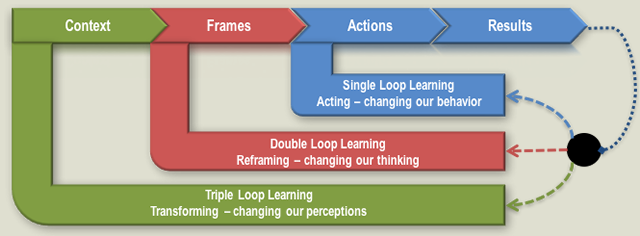Make your leadership more powerful with loop learning
Are you clear on what you are currently focusing on in your teams and what is currently driving their actions? Triple loop learning can help!



As leaders, it is very difficult to create change in our organizations. One of the biggest problems is that over time, we forget what drives our change and what progress we are making. When we work with our teams, change sometimes feels to them as if it lacks structure and meaning.
Triple loop learning (illustrated below) is a model you can apply to make change easier. It helps bring focus to teams and create transformational leadership in organizations.
Let’s talk about triple loop learning and how you can apply this model in real life.
In the first learning loop, your mindset should be to take an action, measure the results, adapt and try again. Each action you take should allow you to learn something that will help you get closer to the result you are looking for.
This is our most natural way of thinking and resolving problems. it is almost our default way of being. Actions can be anything from a behaviour, a change, or a different skill or tactic to get to your next result.
Here is an example from a business perspective. Imagine you have an employee who is not performing well. As a leader, your first action would be to meet with the person to discuss and create an improvement plan. A few weeks later, you would measure to see the results of this plan. This will then lead you to your next action.

The second learning loop focuses on framing, which is how you think of a problem or situation. It puts a clear label on what you are trying to accomplish right now.
The benefit is that changing how you look at something opens up new possibilities to address it. The second learning loop allows you to customize a problem to your own way of thinking. This includes things such as patterns you notice and strategies to solve a problem.
Sometimes the frame is explicit and known to all, but there are times when it’s not so obvious. For example, an implicit frame for teams always in a rush is that they are fighting fires. They may not like it, but they accept this as part of their lives.
What would be different if this team focused on working at a sustainable pace instead? Maybe they would start organizing their work differently or take different actions instead. They would also measure their actions for a different set of results.
Once you reach this point, you and your team are aware of when you are in the first or second learning loops. Your team knows their current frame, and they iterate through the first loop to get results. When they get stuck, they change frames.
What is missing to complete this picture is the third learning loop of context. This loop operates at the level of your beliefs, intentions and your “way of being” as a leader.
Imagine for a moment that you are having an argument with your spouse. Let’s go as far as saying that in the heat of the discussion, your intention is to be right.
How do you behave? Now, in that same argument, what would happen if your intention was to fix things? How do you act now? How does your listening change? How do your words change?
As a leader in your organization, what is it that you really want? People can sense that desire from you every time they are around you, and it inspires them. That desire is so profound it changes your behaviour with others.
Your context will have a direct impact on the frames you decide to set.
Consider the following business examples of context:
Take a piece of paper and write both of these contexts down in separate columns. Beneath each context, identify the frames you can think of for each of them. Push the exercise even further by thinking of possible actions for each of your frames.
My experience with people often gives me the feeling they are stuck in the first learning loop. They are in such a rush to get things done, they don’t even know the current frame of their actions. They know even less about the context their organization works in.
As a leader, the first step is to be aware of the context you are trying to create with your team. At a meta level, where do you want to get with your team? How do you communicate this? How do you raise awareness about this with them?
The next step is to help your teams identify the frame they are currently working in. You may not always need to set the frame yourself, but you need to make sure your team is focusing on one. Using frames to maintain focus will help you lead change in a very different way.
How transformative is your leadership style? How do you communicate your context? How do you enable your teams to discuss and identify the current frame of their actions?
This article was originally published on forbes.com through the Forbes Coaches Council in July 2017.